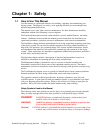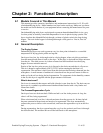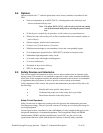
Chapter 2: Functional Description
2-1 Models Covered in This Manual
This manual provides operation, installation, and maintenance instructions for 15, 30 or 60
cfm dehumidifying dryers. Model numbers are listed on the serial tag. Make sure you know
the model and serial number of your equipment before contacting the manufacturer for parts
or service.
Our dehumidifying mini dryers are designed to generate heated dehumidified air (at a very
low dew point) at carefully controlled temperatures for use in plastic drying systems. The
dryer circulates hot dehumidified air through a column of plastic resin in the large drying
hopper. The resin in the hopper is discharged through a slide gate in a “first in, first out”
manner.
2-2 General Description
The Drying System
Dehumidifying dryers are used to generate very low dew point air heated to a controlled
temperature for drying plastic pellets and regrind.
Our dryers force hot, dry air through resin in a drying hopper, where air picks up moisture
from the material and draws it back to the dryer. In the dryer, a desiccant bed strips moisture
from the air. The dried process air is then re-heated and delivered back into the drying
hopper for more moisture removal.
Portion of the low dew point process air is directed to the desiccant tank that is off process.
This air is heated to approximately 450°F (232°C) before entering the bed that is in
regeneration. The moisture is then forced from the desiccant before being exhausted into the
atmosphere. A small amount of ambient air is introduced into the process return air filter to
make up for the air lost during the bed regeneration. To compensate for the humidity content
in the air, this dryer is supplied with the proper amount of desiccant.
What is desiccant?
Desiccant is a material that attracts and holds (absorbs) water from the air. The desiccant our
dryers use is a synthetic crystalline metal aluminosilicate blended with a clay binder and
formed into beads.
The Process/Regeneration Cycle
Our dryers have two desiccant beds. While one bed is on-line in the process air loop, the
other is off-line, being regenerated.
When a desiccant bed is on-line, it absorbs moisture from the process air. In time, the bed
becomes saturated with moisture and needs to be regenerated. The dryer automatically
redirects the process airflow to the second bed, and starts the regeneration cycle on the first
bed.
During regeneration, the dryer system heats the very low dew point air and forces it through
the desiccant bed. The moisture driven off the bed bleeds to the atmosphere.
Portable Drying/Conveying Systems Chapter 2: Functional Description 11 of 63


















